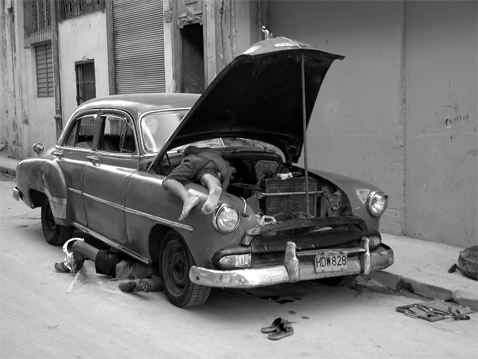I think cars are one of the biggest impediments to getting out of debt and staying out of debt.
They also make it difficult to maintain a fully funded emergency fund (amount differs based on your situation).
Most people need to have at least one car in their family, so there is not much you can do to avoid car related expenses, especially, if you’re trying to drive the car until the wheels fall off.
Personally, I’m trying to join the 200,000 + mile club with both of our cars. We’re trying to save money on cars as much as we can.
One of our cars has been driven 98,000 miles and the other 73,000 miles. So, I realize we’re going to start to experience some maintenance costs that come with normal wear and tear and mechanical failures.
With adequate savings and no car payments (almost) these expenses will hopefully have minimal impact on our financial situation, but it’s good to stay in front of them and have a good game plan for handling car maintenance costs.
What Goes Wrong When?
According to Consumer Reports magazine, cars up to 3 years old can still experience problems.
Most common problems are with body integrity and power equipment-squeaks and rattles and trouble with windows, locks, latches, doors, key less entry, and warning lights, among other items. Cars that are older (8,9, and 10 years old) show such problems more frequently. But, there are also other problems that start occurring: Problems with fuel systems, especially with sensors and check-engine lights, occur more often. Trouble starts with the vehicles’ climate systems at those ages, too. There are also problems related to ball joints, shocks and struts.
Now, I’m certainly no expert in car maintenance repair and costs, but I do know all of those things sound like they can take a good chunk of money. So, how do you minimize such expenses and know when to spend and not to spend on the repairs? Let’s take a look at some tips related to car maintenance spending.
I want you to avoid the temptation to sell your car and buy a new one just to avoid maintenance costs. I’d much rather you maintain your freedom from car payments, or get to that point. Selling and entering into a new car payment certainly isn’t a strategy if you want to reach the 200,000 + mile club.
Car Maintenance Spending Tips
1. Set spending priorities.
Setting your spending priorities on car maintenance is important. Certainly you have to spend to keep the car running properly. For example, regular oil changes are a must.
But do you need to spend the money to fix a power seat that isn’t functioning properly? Maybe not if it doesn’t impact your ability to drive the car and can’t do greater damage to the car’s performance. I know because we’ve been driving one of our cars for more than a year with a power seat issue. Yes, there is some annoyance when it misbehaves, but it’s not absolutely a must to have fixed. Such expenses can drain your savings unnecessarily.
2. Be realistic.
I haven’t always been realistic about car repair expenses. As Consumer Reports points out, older cars are going to have problems. But when you look at these expenses in comparison to having a new car payment each month, paying the repair is almost always a much cheaper route. So, to be realistic, know you’re going to have the expenses and save properly for them. Don’t run out and get a new car because of a few mechanical failures that need to be repaired!
3. Be safe first.
In considering when to spend and not spend, make sure you’re taking the safe route. A trustworthy mechanic can help you make such decisions if you don’t know much about the repair. At the end of the day, the car has to provide two things for you: transportation and safety. It’s not worth taking the cheap route when the mechanical failure could leave you or your family stranded somewhere along the highway.
4. Spend at the right place
You always hear people say to never take a car to the dealership for repair. Rather, find a local and trustworthy mechanic you can build a long-term relationship with. Certainly, some repairs are the same cost with a mechanic as the dealership, but it’s better to find a mechanic who can get to know you and your cars. Such a person can help you know when expenses are coming and help you avoid them with proper care and maintenance.
5. Stay the course to get out of car debt, or stay out!
While it’s tempting to leave your used car behind at the first sign of $1000 mechanical repair; don’t do it. Again, with proper savings you can avoid using a credit card and pay with cash. Plus, keep in mind a new or used car payment would cost more than the $1000 repair in 2-3 months. Stay your course to staying out of debt, or getting out of car debt as soon as possible.
6. Know when it’s time to replace your car?
You may need to consider the purchase of another car after several major repairs. Unfortunately, it’s difficult to determine when it’s time to purchase another car given every situation is a little different. The first thing you should do is again consider your safety. If your car is no longer safe to drive, don’t drive it, or pay to make it safe.
Also, consider your motivation to stay debt free. What type of car could you buy based on the cost of the repairs for your existing car and using some savings (if available)? It may be a good time to invest in another vehicle if the car you could buy is in better condition, it’s safe and you can stay out of debt.
What do you think about these car maintenance tips to help you get car debt free, or stay debt free? Have any tips of your own? Tell us your thoughts in the comments!




Lots of high schools have auto shop classes where you can get minor repairs fixed for a low cost. Students learn valuable work skills, cars are checked by certified mechanics and you feel good and get a good deal. The other option is make friends with someone know knows a thing or two about cars, then when you need something fixed offer a trade a BBQ or dinner in exchange for getting a car fixed. Free labor and you just pay for the parts.
Ugh! Car expenses!
Jason, thanks for writing this article. For whatever reason, many of us live with our heads buried in the sand regarding vehicle maintenance. I’ve met with many folks who treat routine brake pad replacements as a financial emergency.
Saving money monthly is a critical part of owning a car. Setting somewhere between $30-$50 per vehicle per month aside is probably sifficient enough to cover oil changes, tires, tune-ups, etc. for most vehicles. Of course, if something truly unforeseen arises – like an unknown transmission fluid leak (been there, done that!) – emergency funds are always great escape hatches.
Ultimately, you’re right – there aren’t too many unforeseen costs related to vehicle ownership; and jumping into a new car with big payments is definitely not an ideal solution.
Thanks for your insight!
Good tips, I got a new car and looking to preserve it and not spend too much money on maintenance.
You article is so true. I have just had a few major problems on both my cars.
An important thing to remember is to get a good car to start with. Buy the best you can afford. I don’t mean the most expensive, I mean the most reliable, trustworthy car that doesn’t have a list a mile long of common problems.
I have always set aside money each month to take car of car repairs and maintenance. I never wanted to be one of those people stressing because the car is due for a service, needs a new battery, brakes or tyres becasue they can’t afford it. The longer you put those things off, the more damage they can do and end up being even more costly.
Thanks for the advice!
Good article, and sound advice.
I’d say the best advice regarding car maintenance is to simply do it.
No one is going to remind you about this stuff and its truly up to you to keep up with it.
Keeping up with oil changes and tune ups and so forth goes a long way to extending the life of your car.
I think one of the biggest comes from learning to do at least some of the repairs yourself. The more you can do, the more you’ll save. If you’re not a car guy yourself (I’m not!), try to find a friend or acquaintance who is who might be able to help you at least some of the time.
You can save a bundle on car parts via a site called Car-Part.com (I wrote a post on this). It’s a network throughout the US and Canada, where you can get parts for a fraction of what a repair shop will charge.
If you can provide the needed parts, and you have a person who can do your mechanic work on the cheap, you may reach 200,000 miles without paying so much in repairs.
We have 2 cars, 13 and 17 years old and still both under 200,000 miles. So we repair instead of replace. Cost us less than $1,000 last year for repairs, total.
A couple we know just bought a 2 year old car rather than “fix” their transmission on their 6 year old car. The problem? They never had the fluid levels checked and when it got low and the transmission acted funny, they traded it in. Spent $14,000 on a second hand car rather than put fluid in the transmission. And they always complain they have no money!
So, check transmission fluid levels-there’s a dip-stick just like for your oil. But I bet you already know all that!
All of these tips are excellent! These tips can help anyone save time and money later on down the road, if followed. Thanks for sharing!